Table of Contents
CBSE Previous Year Question Papers Class 12 Chemistry 2015 Delhi
Time allowed: 3 hours
Maximum Marks: 70
General Instructions
- All questions are compulsory.
- Section A: Questions number 1 to 5 are very short answer questions and carry 1 mark each.
- Section B: Questions number 6 to 12 are short answer questions and carry 2 marks each.
- Section C: Questions number 13 to 24 are also short answer questions and carry 3 marks each.
- Section D: Questions number 25 to 27 are long answer questions and carry 5 marks each.
- There is no overall choice. However, an internal choice has been provided in two questions of one mark, two questions of two marks, four questions of three marks and all the three questions of five marks weightage. You have to attempt only one of the choices in such questions
- Use of log tables, if necessary. Use of calculators is not allowed.
CBSE Previous Year Question Papers Class 12 Chemistry 2015 Delhi Set I
Question 1.
What is the basicity of H3PO4? [1]
Question 2.
Write the IUPAC name of the given compound: [1]

Answer:
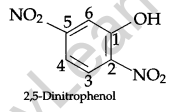
Question 3.
Which would undergo SN2 reaction faster in the following pair and Why? [1]
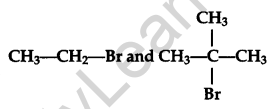
Answer:
Primary alkyl halides will undergo SN2 reactions faster than tertiary alkyl halides because of less steric hindrance experienced by the approaching nucleophile. Hence, out of the given pair, primary alkyl halide (CH3CH2Br) would undergo SN2 reaction faster.
Question 4.
Out of BaCl2 and KCl, which one is more effective in causing coagulation of a negatively charged colloidal Sol? Give reason. [1]
Answer:
According to the Hardy-Schulze rule, the greater the valency of a flocculating ion, the greater is its power to cause precipitation. Between Ba2+ (from BaCl2) and K+ (from KCl), Ba2+ has greater valency. Therefore, BaCl2 will be more effective in causing the coagulation of a negatively charged colloidal sol.
Question 5.
What is the formula of a compound in which the element Y forms ccp lattice and atoms of X occupy 1/3 rd of tetrahedral voids? [1]
Question 6.
What are the transition elements? Write two characteristics of the transition elements. [2]
Answer:
Elements which in their ground state or in any of their oxidation state have partially filled d-orbital are called transition elements. The name ‘transition’ given to the elements of d-block is only because of their position between s-block and p-block elements.
The two characteristics of the transition elements are:
- They show variable oxidation states.
- They generally form coloured compounds.
Question 7.
(i) Write down the IUPAC name of the following complex:
[Cr(NH3)2Cl2(en)]Cl (en = ethylenediamine)
(ii) Write the formula for the following complex:
Pentaamminenitrito-o-Cobalt(III). [2]
Answer:
(i) Diamminedichloridoethylenediaminechromium(III) chloride.
(ii) [Co(NH3)5(ONO)]2+.
Question 8.
Name the reagents used in the following reactions: [2]
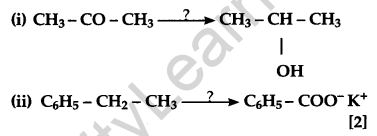
Answer:
(i) Sodium borohydride (NaBH4)/LiAlH4/H2, Pt.
(ii) Alkaline potassium permanganate (KMnO4, KOH).
Question 9.
What is meant by positive deviations from Raoult’s law? Give an example. What is the sign of ∆mixH for positive deviation? [2]
OR
Define azeotropes. What type of azeotrope is for-med by positive deviation from Raoult’s law? Give an example.
Answer:
Positive deviation from Raoult’s law means that the observed vapour pressure is greater than expected, and it occurs when the A – B attractions are weaker than the average of the attractions in the pure component of the mixture. For example, A mixture of ethanol and acetone shows a positive deviation from Raoult’s law.
In case of solutions showing positive deviations, absorption of heat takes place; i.e., ∆mixH has a positive (+) sign.
OR
Azeotropes are the binary mixtures which have the same composition in liquid and vapour phases and boil at a constant temperature.
A minimum boiling azeotrope is formed by solutions showing a large positive deviation from Raoult’s law at a specific composition.
Example: C2H5OH + H2O (An ethanol-water mixture)
Question 10.
(a) Following reactions occur at the cathode during the electrolysis of aqueous silver chloride solution:
Ag+ (aq) + e– → Ag(s); E0 = +0.80 V
H+ (aq) + e– → \(\frac { 1 }{ 2 }\) H2(g); E0 = 0.00 V
On the basis of their standard reduction electrode potential (E0) values, which reaction is feasible at the cathode and why?
(b) Define limiting molar conductivity. Why the conductivity of an electrolyte solution decreases with decrease in concentration? [2]
Answer:
(a) The relationship between the standard free energy change and emf of a cell reaction is given by:
∆G0 = -nFE0
Thus, the more positive the standard reduction potential of a reaction, the more negative is the standard free energy change associated with the process and consequently, the higher is the feasibility of the reaction.
Since E0(Ag+/Ag) has a greater positive value than E0(H+/H) the reaction which is feasible at the cathode is given by
Ag+ (aq) + e– → Ag(s)
(b) The limiting molar conductivity of an electrolyte is defined as its molar conductivity when the concentration of the electrolyte in the solution approaches zero.
The conductivity of an electrolyte solution is the conductance of ions present in a unit volume of the solution. The number of ions (responsible for carrying current) decreases when the solution is diluted or the concentration is decreased. As a result, the conductivity of an electrolyte solution decreases with the decrease in concentration.
Question 11.
3.9 g of benzoic acid dissolved in 49 g of benzene shows a depression in freezing point of 1.62 K. Calculate the Van’t Hoff factor and predict the nature of solute (associated or dissociated). (Given: Molar mass of benzoic acid = 122 g mol-1, Kf for benzene = 4.9 K kg mol-1) [3]
Answer:
We know that the depression in freezing point by
Given: Mass of solute (WB) i.e., C6H5COOH = 3.9 g
Mass of solvent (WA) = 49 g = \(\frac { 49 }{ 1000 }\) kg
Molar mass of C6H5COOH(Ms) = 122 g/mol
Kf = 4.9 K kg/mol
∆Tf = 1.62 K
To find: Van’t Hoff factor (i = ?)
We know that the depression in freezing point is given by:
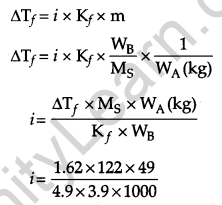
Since, i < 1, hence solute benzoic acid (C6H5COOH) will undergo association in benzene.
Question 12.
- Indicate the principle behind the method used for the refining of zinc.
- What is the role of silica in the extraction of copper?
- Which form of the iron is the purest form of commercial iron? [3]
Answer:
- Zinc is a metal having a low boiling point and it is refined by distillation method which is used for metals having low boiling points.
- During extraction of Copper, FeS or FeO is present as impurity hence SiO2 is added as a flux to form silicate (slag) which can be removed easily as it floats over molten copper (Cu)

- Wrought iron is the purest form of commercial iron.
Question 13.
An element with molar mass 27 g mol-1 forms a cubic unit cell with edge length 4.05 × 10-8 cm. If its density is 2.7 g cm-3, what is the nature of the cubic unit cell? [3]
Question 14.
(a) How would you account for the following:
(i) Actinoid contraction is greater than lanthanoid contraction.
(ii) Transition metals form coloured compounds.
(b) Complete the following equation: [3]
2MnO4– + 6H+ + 5NO2– →
Answer:
(a) (i) The 5 f-orbitals (in case of actinoids) have a poorer shielding effect than 4 f-orbitals (in lanthanoids). Thus, the effective nuclear charge experienced by electrons in valence shells in case of actinoids is much more than that experienced by electrons in valence shells in case of lanthanoids. Hence, the contraction in size in actinoids is greater than that in lanthanoids.
(ii) In the presence of ligands, the d-orbitals of transition metal ions split up into two sets of orbitals having different energies. Thus, the transition of electrons takes place from one set to another. The energy required for these transitions is quite less and falls in the visible region of radiation. The ions of transition metals absorb the radiation of a particular wavelength and the rest is reflected, imparting colour to the solution.
(b) 2MnO4– + 6H+ + 5NO2– → 2Mn2+ + 5NO3– + 3H2O
- Question 15.
(i) Draw the geometrical isomers of a complex [Pt(NH3)2Cl2].
(ii) On the basis of crystal field theory, write the electronic configuration for d4 ion if ∆0 < P.
(iii) Write the hybridization and magnetic behaviour of the complex [Ni(CO)4].
(At. no. of Ni = 28). [3] Answer:
(i) Geometrical isomers of complex [Pt(NH3)2Cl2].
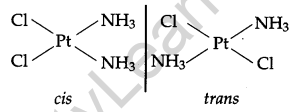
(ii) On the basis of crystal field theory, for a d4 ion if, ∆0 < P. then complex is a high spin complex formed by an association of weak field ligands with the metal ion. As a result, the fourth electron enters one of the eg orbitals, thereby, exhibiting the electronic configuration t2g3 eg1
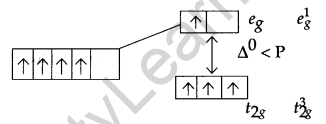
(iii) Outer electronic configuration of Ni atom in the ground state.

Outer electronic configuration of Ni atom in Ni(CO)4
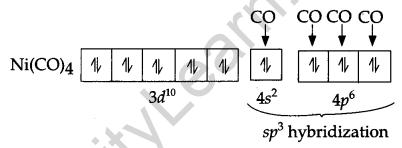
Carbonyl, CO being a strong field ligand causes the pairing of valence electrons in the Ni atom against the Hund’s Rule of Maximum Multiplicity. This results in the formation of an inner orbital complex, [Ni(CO)4]. Since the complex [Ni(CO)4] has no unpaired electron, it is diamagnetic in nature and posses tetrahedral shape.
Question 16.
Calculate emf of the following cell at 25°C: [3]
Fe | Fe2+(0.001M) | H+(0.01M) | | H2(g) (1 bar)
Pt(s) E0(Fe2+ | Fe) = -0.44 V E0(H+/H2) = 0.00 V.
Answer:
For the given cell representation, the cell reaction will be
Fe(s) + 2H+(aq) → Fe2+(aq) + H2(g)
The standard emf of the cell will be
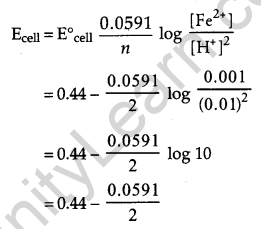
Ecell = 0.4105 V2 ~ 0.41 V
Question 17.
Give reasons for the following observations:
(i) Leather gets hardened after tanning.
(ii) Lyophilic sol is more stable than lyophobic sol.
(iii) It is necessary to remove CO when ammonia is prepared by Haber’s process. [3]
Answer:
(i) Animal skin (hide) is colloidal in nature and has positively charged colloidal particles. When a hide is soaked in tanning, mutual coagulation takes place and as a result, leather gets hardened.
(ii) The stability of the lyophilic solution depends on the two factors, the presence of a charge and the solvation of colloid particles. On the other hand, the stability of lyophobic solutions is only because of the presence of a charge. Thus, the lyophilic solution is more stable than a lyophobic solution due to the extensive solvation.
(iii) It is necessary to remove CO when ammonia is prepared by Haber’s process because in this process the CO acts as a poison and adversely affects the activity of the iron catalyst, used in the process.
Question 18.
Write the names and structures of the monomers of the following polymers:
(i) Nylon-6,6
(ii) PHBV
(iii) Neoprene. [3]
Answer:
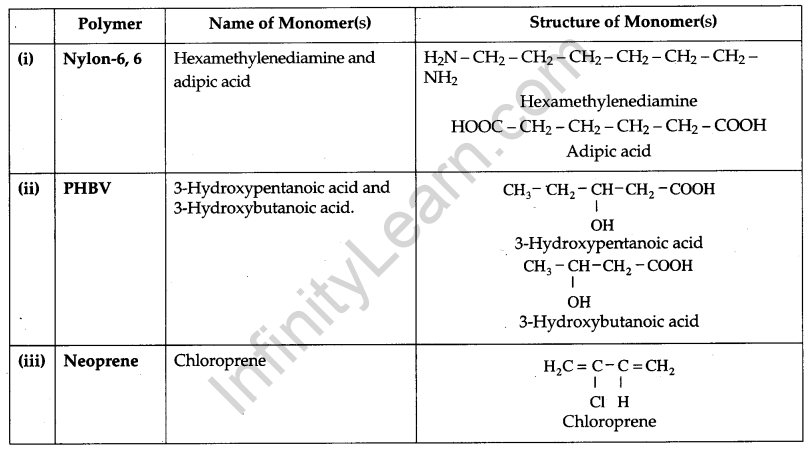
Question 19.
Predict the products of the following reactions:
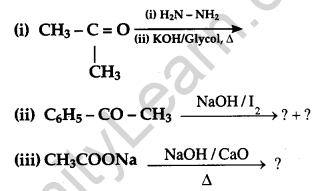
Answer:
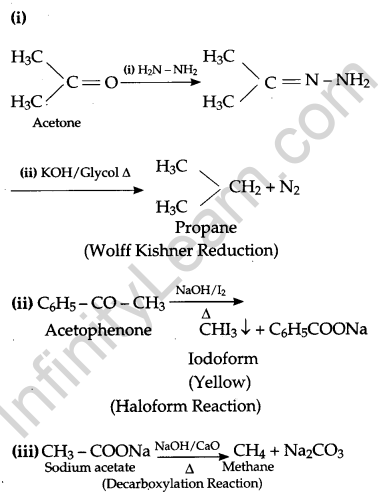
Question 20.
How do you convert the following:
(i) Phenol to anisole
(ii) Propane 2-ol to 2-methyl propane-2-ol
(iii) Aniline to phenol [3]
OR
(b) Write the mechanism of the following reaction:
![]()
(b) Write the equation involved in the acetylation of Salicyclic acid. [3]
Answer:
(i)


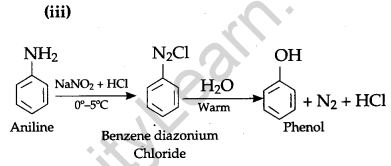
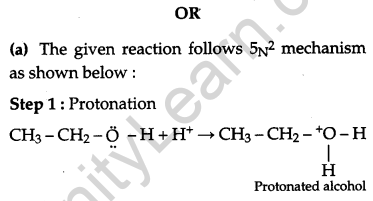
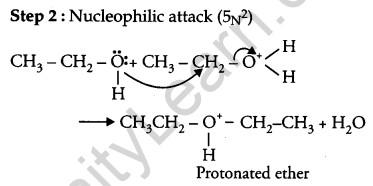

Question 21.
(i) Which one of the following is a disaccharide:
Starch, Maltose, Fructose, Glucose?
(ii) What is the difference between fibrous protein and globular protein?
(iii) Write the name of the vitamin whose deficiency causes bone deformities in children. [3]
Answer:
(i) Maltose is a disaccharide, as it contains α-D-glucose units.
(ii)
| S.No. | Fibrous Proteins | Globular Proteins |
| 1. | In fibrous proteins, the polypeptide chains, run parallel and are held together by strong hydrogen and disulphide bonds. | In globular proteins, the polypeptide chains are folded looped or trusted around themselves, giving these proteins a spherical structure. |
| 2. | They are usually insoluble in water. | They are usually soluble in water. |
| 3. | They are structural proteins. For example, keratin is present in nails and hair, collagen is present in tendons and myosin is present in muscles. | They are functional proteins. For example, most enzymes and some hormones like insulin. |
(iii) Deficiency of Vitamin D causes bone deformities in children.
Question 22.
Give reasons:
(a) n-Butyl bromide has a higher boiling point than t-butyl bromide.
(b) A racemic mixture is optically inactive.
(c) The presence of the nitro group (-NO2) at o/p positions increases the reactivity of haloarenes towards nucleophilic substitution reactions. [3]
Answer:
(a) n-butyl bromide is a straight-chain molecule having a larger surface area and therefore, has stronger intermolecular forces. On the other hand, f-butyl bromide (CH3)3 CBr is a branched molecule, so it has a smaller surface area. Hence, it has weaker intermolecular force.
(b) A racemic mixture is an equimolar solution of two enantiomers (d and l forms) and thus, the rotation due to one isomer is cancelled by the rotation due to another. Therefore, it has zero optical rotation and hence, it is optically inactive.
(c) This is because the nitro group (-NO2) at o/p positions withdraw the electrons from the benzene ring. The reduced electron density at o/p positions for haloarenes facilitates the attack of the nucleophile. The negative charge in the Carbanion formed, at o/p positions with respect to halogen atom is stabilised through resonance and due to the presence of nitro groups (NO2) respectively.
Question 23.
Mr Roy, the principal of one reputed school organized a seminar in which he invited parents and principals to discuss the serious issue of diabetes and depression in students. They all resolved this issue by strictly banning junk food in school and to introduce healthy snacks and drinks like soup, lassi, milk etc. in school canteens. They also decided to make compulsory half an hour of physical activities for the students in the morning assembly daily. After six months, Mr Roy conducted the health survey in most of the schools and discovered a tremendous improvement in the health of students.
After reading the above passage, answer the following:
(i) What are the values (at least two) displayed by Mr Roy?
(ii) As a student, how can you spread awareness about this issue?
(iii) What are tranquillizers? Give an example.
(iv) Why is the use of aspartame limited to cold foods and drinks? [4]
Answer:
(ii) As a student, I can spread awareness regarding diabetes and depression among students by conducting seminars, health camps, debates, distribution of templates, and workshops by doctors. So as to highlight the needs to follow healthy eating.
(iii) Tranquillizers are neurologically active drugs that induce a sense of well being and are used to treat stress, anxiety and mild or severe mental disease. They perform their function by inhibiting the message transfer mechanism from nerve to receptor e.g., Equanil, meprobamate and iproniazid etc.
(iv) The use of aspartame is limited to foods and cold drinks because aspartame is unstable at cooking temperature.
Question 24.
(a) Account for the following:
(i) Acidic character increases from HF to HI.
(ii) There is a large difference between melting and boiling points of oxygen and sulphur.
(iii) Nitrogen does not form pentahalide.
(b) Draw the structures of the following:
(i) ClF3
(ii) XeF4 [5]
OR
(i) Which allotrope of phosphorus is more reactive and why?
(ii) How the supersonic jet aeroplanes are responsible for the depletion of ozone layers?
(iii) F2 has a lower bond dissociation enthalpy than Cl2. Why?
(iv) Which noble gas is used in filling balloons for meteorological observations?
(v) Complete the equation:
XeF2 + PF5 →
Answer:
(a) (i) The acidic strength of the hydrohalic acids increases from HF to HI because the stability of the acids decreases from HF to HI on account of a decrease in bond dissociation enthalpy of H – X bond from HF to HI.
(ii) The difference in melting point and boiling point of oxygen and sulphur is due to the difference in their atomicities oxygen exists as a diatomic (O2) molecule, while sulphur exists as a polyatomic (S8) molecule and also oxygen is small in size and has high electronegativities.
(iii) Being an element of the second period, Nitrogen has no ‘d’ orbitals and its maximum covalency is restricted to four. Hence, due to the non-availability of d-orbitals, it can’t form pentahalides.
(b) (i) Structure of ClF3

(ii) Structure of XeF4
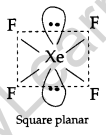
OR
(i) White phosphorus is most reactive of all the allotropes of phosphorus. It is because it exists as P4 discrete tetrahedral units with 60° angle, which results in angular strain and makes it highly reactive.
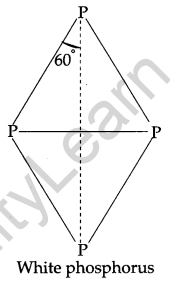
(ii) Since supersonic jets fly in the stratosphere near the ozone layer, they are responsible for the depletion of the ozone layer. The oxide emitted from the exhausts of supersonic jet aeroplanes readily combine with ozone to form nitrogen dioxide and diatomic oxygen.
NO(g) + O3 (g) → NO2 (g) + O2 (g)
(iii) The size of a fluorine atom is very small as compared to a chlorine atom. Therefore, the repulsion between electrons in the outer most shell of the two atoms in a fluorine molecule is much greater than that in a chlorine molecule. Hence, it requires less energy to break up the fluorine molecule, making its bond dissociation energy lesser than that of a chlorine molecule.
(iv) Helium, gas is used for filling of balloons for meteorological observations.
(v) XeF2 + PF5 → [XeF]+ [PF6]–
Question 25.
An aromatic compound ‘A’ of molecular formula C7H7ON undergoes a series of reactions as shown below. Write the structures of A, B, C, D and E in the following reactions.
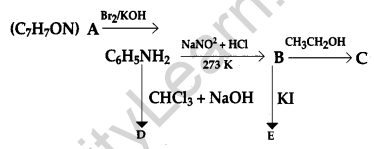
OR
(b) Write the structures of main products when aniline reacts with the following reagents:
(i) Br2 water
(ii) HCl
(iii) (CH3CO)2O/pyridine.
(b) Arrange the following in the increasing order of their boiling point:
C2H5NH2, C2H5OH, (CH3)3N
(c) Give a simple chemical test to distinguish between the following pair of compounds:
(CH3)2NH and (CH3)3N.
Answer:
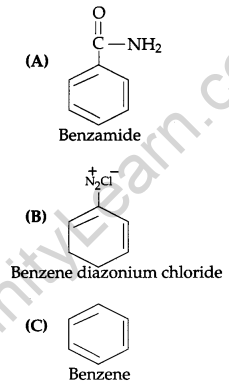
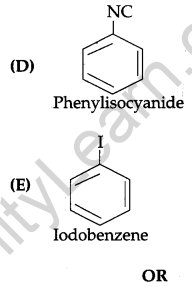
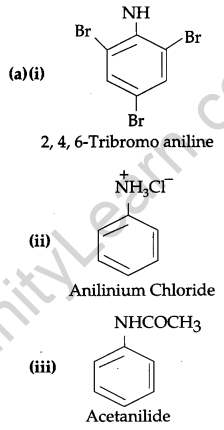
(b) Ethanol has a high boiling point then ethylamine because of oxygen, being more electronegative forms strong extensive hydrogen bond as compared to that of nitrogen. In trimethylamine, there is no hydrogen and hence has the lowest boiling point.
Increasing order or boiling point.
(CH3)3N < C2H5NH2 < C2H5OH.
(c) (CH3)2NH reacts with benzene sulphonyl chloride (Hinsberg reagent) as follows:
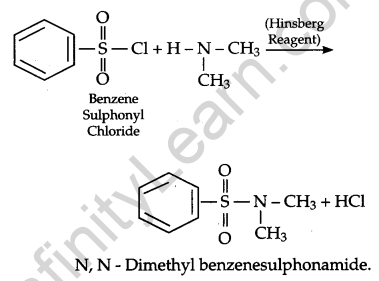
(CH3)3N does not react with benzene sulphonyl chloride.
Question 26.
For the hydrolysis of methyl acetate in aqueous solution, the following results were obtained:

(i) Show that it follows pseudo-first-order reaction, as the concentration of water remains constant.
(ii) Calculate the average rate of reaction between the time interval 30 to 60 seconds. (Given log 2 = 0.3010, log 4 = 0.6021) [5]
OR
(a) For a reaction A + B → P, the rate is given by
Rate = k [A] [B]2
(i) How is the rate of reaction affected if the concentration of B is doubled?
(ii) What is the overall order of reaction if A is present in large excess?
(b) A first-order reaction takes 30 minutes for 50% completion. Calculate the time required for 90% completion of this reaction. (log 2 = 0.3010)
Answer:
For the hydrolysis of methyl acetate in aqueous solution:
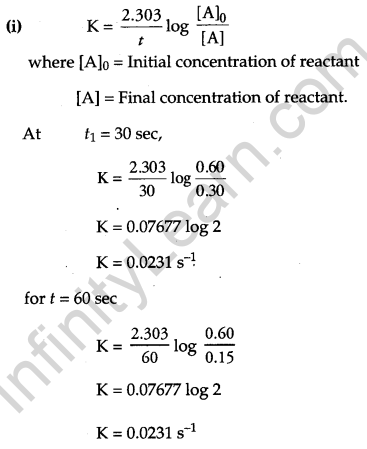
K is the same for both the cases hence it is the pseudo-first-order reaction.
(ii) The average rate of reaction between the time interval of 30 – 60 seconds is given by
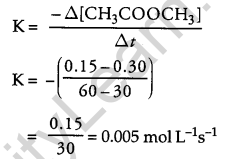
OR
(a) (i) Since the given reaction has order two with respect to reactant B, thus if the concentration of B is doubled in the given reaction, then the rate of reaction will become four times.
(ii) If the concentration of B is doubled i.e.; [B]2 the overall reaction will be two, because if A is present in large excess, then the reaction will be independent of the concentration of A and will be dependent only on the concentration of B.
Order of reaction = 2.
(b)
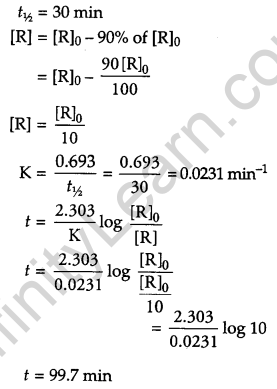
Note: All questions of Delhi Set-II are from Delhi Set I and Delhi Set-III are from Set I and II.
For more visit CBSE Previous Year Question Papers Class 12 Maths 2016 Delhi




